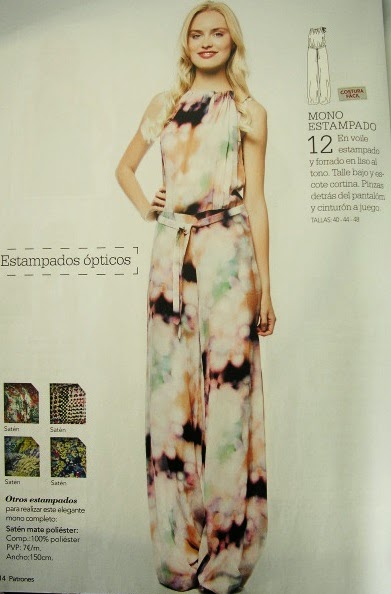DESCRIPTION: The original pattern is for a straight unlined jacket with built-in hood and a single snap closure at waist level; there are no pockets or belt. I've added a full lining, a belt, two patch pockets and four buttons along the front edge, instead of the single snap.
PATTERN: Burda World of Fashion 2007 model 126 (traced size 38); my magazine is in French because in 2007 Burda wasn't publishing the Portuguese edition just yet. Below you can see a snapshot of the pattern and how the body and hood are cut as a single piece.
DESCRIÇÃO: O molde original é de uma jaqueta sem forro com capucho e com apenas uma mola de pressão ao nível da cintura; não tem bolsos nem cinto. Acrescentei um forro completo, cinto, dois bolsos-chapa e em vez da mola, quatro botões ao longo da frente.
MOLDE: Burda Tendences Mode, modelo 126 (cortei o 38); a revista é a edição francesa porque em 2007 ainda não se publicava a edição Portuguesa da Burda. Mais abaixo podem ver uma foto do molde, onde se percebe que o corpo e o capucho são cortados numa peça única de tecido.
Side and back views / Vista de lado e de trás:
A close-up of the tie-belt / Detalhe do cinto de atar:
For the belt loops I used buttonhole twist thread; there are no side seams and I anchored the loops using two small buttons inside, as you can see below:
---
Para as passadeiras do cinto usei linha torçal; para prender bem sem arriscar esgaçar o tecido (uma vez que não há costuras laterais), usei dois botões pequeninos no interior, como podem ver mais abaixo:
The patch pockets / os bolsos-chapa:
Here's a view of the lining back fold for wearing ease; I've also tacked the lining to the jacket at the center of the back neck seam (the lining was cut using the jacket pattern excluding the edge facings/ hem facings width and adding SAs, so the hood is also included; hence the need of hand-tacking it at the back neck) and bellow the armholes.
---
Podem ver aqui a dobra do forro no centro das costas; dei uns pontos à mão no centro da costura do decote atrás e também por baixo da costura da cava para prender o forro ao casaco e evitar que se desloque. O molde do forro é conseguido a partir do molde do casaco, excluindo a largura das bainhas /orlas e acrescentando margens de costura, por isso o capucho também fica incluído; é por isto que deve ser preso ao casaco na costura do decote atrás.
CONCLUSION: This project took some time to complete and also I was improvising along the way; I only decided to add the full lining after the jacket was completed so I stitched it to the jacket entirely by hand; then I decided to add the belt and only in the end I felt that just one button at waist level wasn't going to be enough for me. As with the previous project using the same fabric, I took some care matching the stripes, choosing to align them horizontally; I matched the stripes on the patch pockets and also on the sleeves and I am really satisfied with the end result. Have a wonderful weekend guys, and thank you for visiting!
ETA: Just a quick note to mention that I interfaced the edge facings and hem facings and also the pocket placement area and back neckline/shoulder/armhole using fusing tape! There is no mention to interfacing in Burda's instructions, but they do mention using bias tape as hem/facing finishing and also bound the armhole/neck/shoulder allowances, since this is originally an unlined jacket.
ETA: Just a quick note to mention that I interfaced the edge facings and hem facings and also the pocket placement area and back neckline/shoulder/armhole using fusing tape! There is no mention to interfacing in Burda's instructions, but they do mention using bias tape as hem/facing finishing and also bound the armhole/neck/shoulder allowances, since this is originally an unlined jacket.
---
CONCLUSÃO: Este projeto demorou algum tempo a terminar, pois o meu tempo livre é mesmo muito pouco e além disso foi sendo improvisado à medida que avançava. Por exemplo, só decidi forrar a jaqueta depois desta estar finalizada, por isso tive de coser o forro à mão à jaqueta. Depois disso é que achei que ficava bem com um cinto; finalmente concluí que apenas um botão era pouco e acrescentei os restantes. Tal como as calças do mesmo tecido que mostrei anteriormente, tive o cuidado de alinhar as riscas de forma a coincidirem perfeitamente ao longo da frente e entre as mangas e o corpo da jaqueta, optando pela direção horizontal. Também fiz com que as riscas dos bolsos coincidissem, de forma a parecerem quase invisíveis. Fiquei muito satisfeita com o resultado final, valeu bem a pena o tempo que demorou a fazer. Tenham todos um ótimo fim-de-semana e obrigada por visitarem!
Apenas uma nota adicional: apliquei entretela às orlas da bainha e nas orlas da frente, assim como fita de entretela nas costuras das cavas, ombro e decote atrás. As instruções da Burda não mencionam qualquer entretela, apenas dizem para usar fita de viés para o acabamento das orlas, decote atrás e costuras de aplicação das mangas, uma vez que a jaqueta original não é forrada.
Apenas uma nota adicional: apliquei entretela às orlas da bainha e nas orlas da frente, assim como fita de entretela nas costuras das cavas, ombro e decote atrás. As instruções da Burda não mencionam qualquer entretela, apenas dizem para usar fita de viés para o acabamento das orlas, decote atrás e costuras de aplicação das mangas, uma vez que a jaqueta original não é forrada.




























